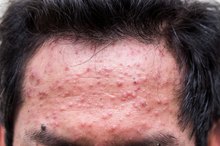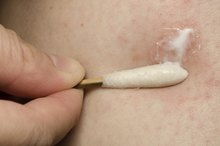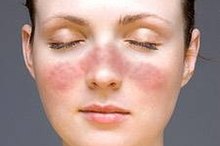What does fact checked mean?
At Healthfully, we strive to deliver objective content that is accurate and up-to-date. Our team periodically reviews articles in order to ensure content quality. The sources cited below consist of evidence from peer-reviewed journals, prominent medical organizations, academic associations, and government data.
- Alcohol and public health: Frequently asked questions. (2013)
- Alcohol use disorder. (n.d.)
- Alcohol use in older people. (2013)
- Fact sheets - Excessive alcohol use and risks to men's health - Alcohol. (2016, March 7)
- Overview of alcohol consumption. (n.d.)
The information contained on this site is for informational purposes only, and should not be used as a substitute for the advice of a professional health care provider. Please check with the appropriate physician regarding health questions and concerns. Although we strive to deliver accurate and up-to-date information, no guarantee to that effect is made.
Alcoholism Related Skin Disorders
**Alcohol dependence, or alcoholism, is characterized by increasing tolerance, cravings and withdrawal symptoms 1. When alcohol is absorbed into the bloodstream from the digestive tract, it is quickly distributed to all parts of the body and has effects on all major systems, including the skin. Excessive alcohol use may also impact skin health by affecting personal grooming habits and nutrition 46. Alcohol abuse is associated with several skin disorders.
Redness and Flushing
Skin symptoms may be recognizable at an early stage of the disease and be useful in the diagnosis of alcoholism 1. A flushing reaction to drinking alcohol, which is due to an enzyme deficiency and more common in those of East Asian descent, has been linked to an increased risk of alcohol-induced esophageal cancer by scientists from the National Institute on Alcohol Abuse and Alcoholism 1. The conclusions were made from a review of studies and announced by "NIH Health" on March 23, 2009. Other skin conditions common in alcoholics may include hives and a worsening of existing rosacea, a disorder characterized by redness, pimple-like bumps and thickening skin on the nose and cheeks.
Symptoms of Liver Cirrhosis
Common Skin Rashes on the Face
Learn More
Long-term alcohol abuse is one of the most common causes of liver scarring, or cirrhosis. The liver normally processes dietary proteins, carbohydrates, fats and vitamins, produces clotting factors and breaks down toxins in the blood. Impaired liver function may result in redness or mottling on the palms of the hands. Skin may bruise easily and itch all over. Other symptoms of cirrhosis may include yellowed complexion and the appearance of spider veins on the trunk, face, arms and hands. The American Academy of Family Physicians states that the number and size of spider veins can be correlated to the severity of chronic liver disease.
- Long-term alcohol abuse is one of the most common causes of liver scarring, or cirrhosis.
- Other symptoms of cirrhosis may include yellowed complexion and the appearance of spider veins on the trunk, face, arms and hands.
Psoriasis
Heavy drinkers are more likely to have psoriasis than nondrinkers, and alcohol intake is known to exacerbate existing psoriasis. As part of the Nurses Health Study II, researchers looked for an association between new cases of psoriasis and alcohol use 4. A group of 82,869 women who reported they drank alcohol and had no history of psoriasis were followed for 14 years, beginning in 1991. Of the group, 1,150 developed psoriasis, a significantly higher rate than nondrinkers in an original cohort of 116,671 women. Subjects who developed psoriasis reported drinking 2 to 3 drinks per week or more. An association between psoriasis and drinking regular beer was strongest in a subset of women who drank 5 or more drinks per week, while light beer and other forms of alcohol were not shown to be a significant risk for new cases of psoriasis in this study. Scientists do not know exactly how alcohol influences psoriasis, but theorize that immunological changes, increased inflammation or sensitivity to gluten in the barley that's used to make beer may be causative. The findings were published in the August 2010 issue of the journal "Archives of Dermatology."
- Heavy drinkers are more likely to have psoriasis than nondrinkers, and alcohol intake is known to exacerbate existing psoriasis.
- An association between psoriasis and drinking regular beer was strongest in a subset of women who drank 5 or more drinks per week, while light beer and other forms of alcohol were not shown to be a significant risk for new cases of psoriasis in this study.
Related Articles
References
- Alcohol abuse and alcoholism. (n.d.)
- Alcohol and public health: Frequently asked questions. (2013)
- Alcohol use, abuse and dependency. (2011, May 26)
- Alcohol use disorder. (n.d.)
- Alcohol use in older people. (2013)
- Fact sheets - Excessive alcohol use and risks to men's health - Alcohol. (2016, March 7)
- Overview of alcohol consumption. (n.d.)
- Understanding alcohol use disorders and their treatment. (2012, March)
- American Psychiatric Association. Diagnostic and statistical manual of mental disorders (5th ed.). Washington, DC. 2013.
- Cleveland Clinic. Alcoholism. Updated July 29, 2014.
- National Institute on Alcohol Abuse and Alcoholism. Alcohol use disorder: a comparison between DSM–IV and DSM–5 NIH Publication No. 13–7999. November 2013.
- Castillo-Carniglia A, Keyes KM, Hasin DS, Cerdá M. Psychiatric comorbidities in alcohol use disorder. Lancet Psychiatry. 2019;6(12):1068-1080. doi:10.1016/S2215-0366(19)30222-6
- Cleveland Clinic. Alcoholism: management and treatment. Updated July 29, 2014.
Writer Bio
Mary Earhart is a registered nurse, a public health nurse and licensed midwife. Her articles have appeared in professional journals and online ezines. She holds a Bachelor of Science in nursing from California State University at Dominguez Hills. She works in a family practice clinic, has a home birth practice and her specialty is perinatal substance abuse.









